Hunting and calling black bears in the Fall means sounding like a free meal. With Winter and a long nap ahead of it, a black bear will put on an additional 100 – 150% more weight during the Fall. And the black bear isn’t just hungry; it is suffering from Hyperphagia—an intense, maddening sensation of hunger that does not subside even when its belly is full.
Of the two methods of calling black bears, blind or spot and stalk, the spot and stalk technique is the most effective way to increase your odds of using your bear tag this season.
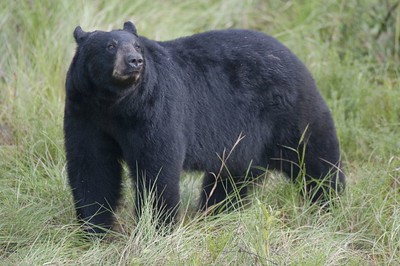
The best method for calling black bears during the Fall is to locate one first visually, stalk to a nearby spot that provides cover, and use prey sounds to lure the bear to within effective range of your weapon.
Related: 4 tips for hunting bears.
Use Spot and Stalk when calling black bears during the Fall.
The spot and stalk method is effective, but that doesn’t mean it is easy or always results in a successful hunt.
First, a black bear’s vision isn’t as awful as you may believe. We know black bears can see some colors. And, while the older a bear gets, the worse its eyesight becomes, a younger black bear can see just about as well as you can.
The weakness of a black bear’s eyesight is the location of its eyes and the focus of its brain. Like all predators, a bear’s eyes are located in front. On the other hand, Prey animals have eyes set on the side. Hence the phrase, “Eyes in front, it likes to hunt. Eyes on the side, it likes to hide.”
A black bear in the fall is concerned about little more than securing a meal, and its eyes are focused on what is directly ahead. The hyperphagia forces it to keep constantly moving and searching for more food. Ravenously hungry bears are willing to take chances and approach areas they would usually avoid, and they are so absorbed in their need to quell the hunger pains that they barely pay any attention to you and your approach. Lastly, hyperphagia leaves a bear sleep-deprived (getting less than four hours a day).
Related: Read my article here on Bear Hunting for Beginners.
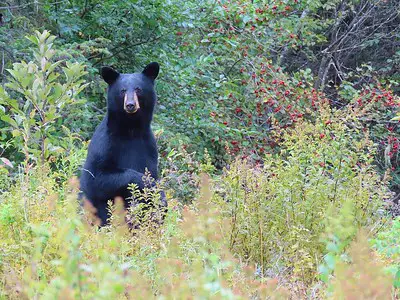
How to successfully sneak up on a black bear while hunting.
If the black bear has one advantage over you, it is its sense of smell. Researchers believe bears have a better sense of smell than any other animal.
Many hunters use one of two forms of scent control to defeat this powerful defense.
Using cover scents while hunting black bears.
A cover scent eliminates or masks the odor of you and your equipment. These products include laundry detergents, dryer sheets, hair shampoos, and body washes. Scent killers spray also meant to be applied after arriving at your hunting spot. These are sprayed on you, the bottom of your boots, and all over the rest of your gear.
You can check for prices on reviews for these products on Bear scents.
Playing the wind when stalking a black bear.
Playing the wind is nothing more scientific or expensive than always making sure the wind blows your scent AWAY from the bear. During your approach, playing the wind isn’t tricky. During the calling phase, however, it can get a bit complicated.
Like a coyote, even a hungry bear will sometimes demonstrate a bit of caution and take one extra step to ensure its safety. That step is to circle behind you and catch the scent of whatever is making the sounds that caught its attention. As you approach, you will need to find a calling spot that won’t give the bear one last chance to sniff you out.
Since that sound maker is you, and your hunt ends if it detects you, you need to prevent this if possible.
How do you keep a bear from circling downwind behind you? Honestly? Well, a bit of luck and a miracle or two would be great. Barring that, if the terrain allows, a height advantage is one way to prevent it.
But, yeah, it’s usually only a miracle that keeps a bear from circling you if it wants to. Hey, you got lucky and spotted one, right? Maybe that luck will hold for a bit longer.
Related: How to tell a bear sow from a boar.
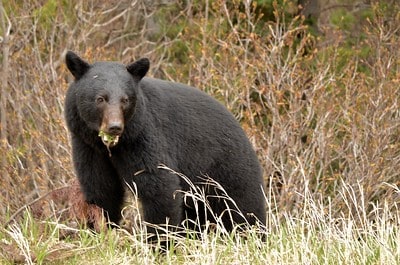
Don’t mistake a cover scent for a bear attractant.
If you are a new predator or bear hunter, you must not mistake a bear attractant for a bear cover scent.
A bear attractant isn’t made to cover the odor of your approach. Bear attractants appeal to a bear’s love of grease and sweets. A bear deep in the throes of hyperphagia will come for you with a vengeance.
Dousing yourself with bear attractant is an excellent way to become a local news story.
Do not apply bear attractants to yourself or your equipment. It could result in great bodily harm or death.
Related: What does black bear poop look like?
Beware this booby trap when calling black bears.
Another hazardous situation a new bear hunter can face occurs when the hunter cannot tell a sow from a boar. While that is the subject of a different article, one sure way is to confirm there is only one bear in the area. If you see multiple bears, that’s often a sow with cubs.
If you do stalk a sow by mistake, here’s that booby trap to watch out for as you proceed.
Mamma doesn’t like having her kids wrestling around out in the open. To keep them safe while she is eating, she’ll tuck them into a nice, hidden area while she is foraging. Poor you, so fixated on your target as you are, you never notice the cubs and end up right smack between them and momma.
The cubs catch your scent or spot you and begin bawling in fear. Surprised by the sudden commotion, you spin around and realize your mistake.
Your last words are similar to those of an airplane captain whose cockpit window is full of a mountain.
If you also ignored my warning about applying bear attractants to yourself, you’ll soon be a meal the bear family talks about until they go to bed in the Winter.
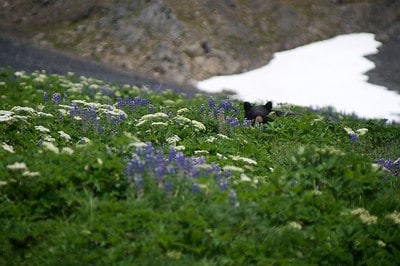
The best bear calling sounds to use during the Fall.
After you have reached a place to begin calling, what sounds will work best to get the bear’s attention, start it in your direction, and remain committed until you take your shot?
Well, remember, first of all, this is the Fall. Secondly, you must keep visual contact with the bear throughout the calling phase.
Forget using bear vocalizations in the Fall.
In the Fall, you can safely discard all of the bear vocalizations. For example, bears mate in the Summer, so you can forget that one even if you haven’t realized how useless sow-in-heat calls are yet (bears rarely make a sound while mating).
And using a cub in distress sound is downright unethical. You bring in and take a sow at best but never realize she was trying to protect her nearby cubs. That’s a death sentence for the cubs.
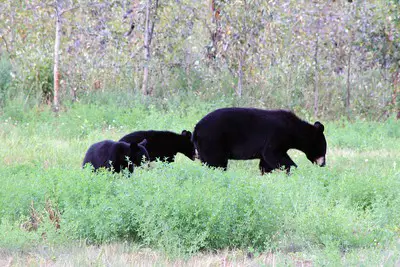
Prey in distress sounds for calling black bears in the Fall.
Before we look at which prey in distress calls to use, it’s important to stress one well-known fact: black bears quickly lose interest in any sound—almost the second it ceases to be heard. So, while taking a quick breather (if using a mouth call) is acceptable, keep the break short.
What about that perfect sound? The one call that works 100% of the time? Sadly, it doesn’t exist. You may be calling a bear standing over a dead deer that you can’t see, or any other number of unknown factors could all add up to a disinterested bear that refuses even to acknowledge your calls.
However, what has the best chance of working is pretty much an open secret: The screams of a dying rabbit and the sounds of a fawn in distress.
As a predator hunter (and bears are predators, I’ll give you that), you might be sorely tempted to use an electronic caller here.
Be aware that some state laws prohibit the use of electronic callers for bear hunting. However, there are two things to consider before you go that route. First, can you even legally use an electronic caller where you are hunting?
Secondly, some research indicates bears might be a bit too smart to be tricked by sounds that repeat too (i.e., they might be able to count).
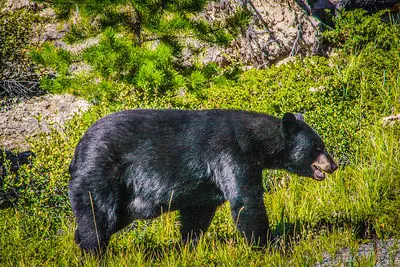
Using a fawn in distress or rabbit squealer to call in a black bear.
I recommend you use a mouth or hand caller when calling black bears. This is because you (a mortal) cannot reproduce the same sound twice. When you try to call a bear with such a device, you will change the volume, tone, and pitch. And that, if nothing else, will sound (forgive me) less human and more like an animal.
Yes, you can buy a Primos Coyote Bear Buster Call. Yes, it costs less than most handmade callers. And yes, I even get a small commission (at no extra charge to you) if you buy it from that Amazon link.
However, I urge you to buy Brian Rush’s Rabbit Squealer. This caller works better, is handmade, and lasts a lifetime. And I have no financial relationship with Mr. Rush.
So, why use a Rush Custom Caller? Rush’s caller lets you take advantage of that human inability to reproduce a sound, letting you add emotions to the call. You can make some compelling and emotional sounds with Rush’s callers. And, like a violin, you soon learn to play unique sounds and have never fluttered over even the most called over fields in the world.
Maintain visual contact with the bear during the calling phase.
Keeping an eye on the bear is crucial because you can gauge the bear’s response to your calls. If it continues to close the distance between you, maintain your calling sound, volume, and rhythm.
One of the best signs you have gotten the bear’s interest is if it stands up and looks in your direction. Often such an act will expose the bear just long enough for you to take a shot.
Another reason to keep an eye on the bear? Not every bear will come all the way in for a perfect shot, but a percentage will get just close enough for an ethical one. By keeping an eye on the bear, you will always be ready to take that shot if it breaks cover long enough.
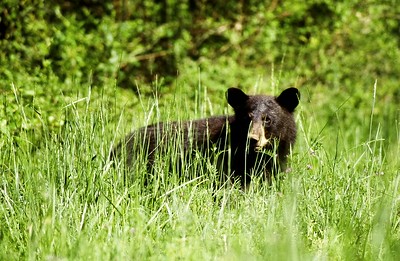
How long do you spend calling black bears during the fall?
When you use the spot and stalk technique, you have the edge—you know there is a bear in the area. Is there any reason, at all, to stop calling?
Well, bears do have that short attention span we mentioned earlier. If you stop calling for too long, they stop approaching. But this shouldn’t be the end of your hunt. Getting that bear to resume requires nothing more than continuing your calling sequence.
But what if the bear finds something more interesting than the sounds you are making? Or, what if the bear refuses to respond? Should you give up? Is it time to pack up and leave?
Not at all! First of all, bears are not lazy. Hyperphagia is in play here; your bear HAS to KEEP eating. If it doesn’t react to your call, you simply do not sound like a tasty free meal to it. However, keep calling and give it a few minutes, and things may change.
Unless you stop calling and the bear finds something to eat, it should not stop. If it does, keep calling. It will eventually resume hunting, and you should sound like a readily available food source.
Hyperphagia and a visible bear equal no call duration time limits. Keep calling until that black bear is no longer visible.
Calling a bear off of food isn’t impossible. But so is an unlimited supply of food; your calls will eventually drag even the most resistant bear directly to you.
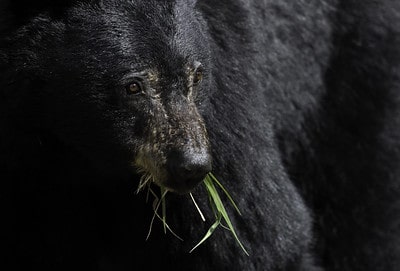
The best time for calling black bears is during the Fall.
Calling black bears is never easier than during the Fall. They are distracted, hungry, constantly moving, and delicious targets. With a stealthy approach and a willingness to keep calling, you will fill your bear tag and take a prize trophy home.

